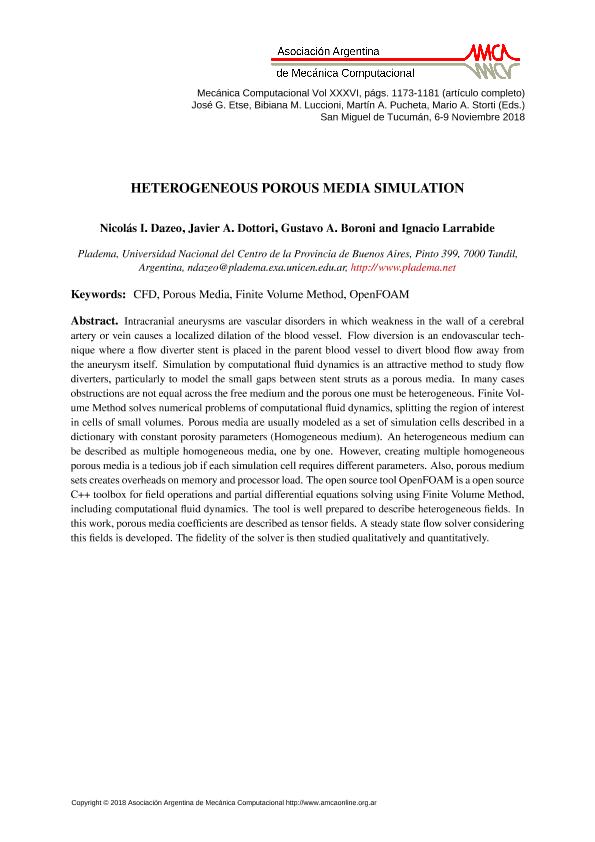Artículo
Heterogeneous Porous Media Simulation
Fecha de publicación:
11/2018
Editorial:
Asociación Argentina Mecánica Computacional
Revista:
Mecánica Computacional
ISSN:
2591-3522
Idioma:
Inglés
Tipo de recurso:
Artículo publicado
Clasificación temática:
Resumen
Intracranial aneurysms are vascular disorders in which weakness in the wall of a cerebral artery or vein causes a localized dilation of the blood vessel. Flow diversion is an endovascular technique where a flow diverter stent is placed in the parent blood vessel to divert blood flow away from the aneurysm itself. Simulation by computational fluid dynamics is an attractive method to study flow diverters, particularly to model the small gaps between stent struts as a porous media. In many cases obstructions are not equal across the free medium and the porous one must be heterogeneous. Finite Volume Method solves numerical problems of computational fluid dynamics, splitting the region of interest in cells of small volumes. Porous media are usually modeled as a set of simulation cells described in a dictionary with constant porosity parameters (Homogeneous medium). An heterogeneous medium can be described as multiple homogeneous media, one by one. However, creating multiple homogeneous porous media is a tedious job if each simulation cell requires different parameters. Also, porous medium sets creates overheads on memory and processor load. The open source tool OpenFOAM is a open source C++ toolbox for field operations and partial differential equations solving using Finite Volume Method, including computational fluid dynamics. The tool is well prepared to describe heterogeneous fields. In this work, porous media coefficients are described as tensor fields. A steady state flow solver considering this fields is developed. The fidelity of the solver is then studied qualitatively and quantitatively.
Palabras clave:
CFD
,
Porous Media
,
Finite Volume Method
,
OpenFOAM
Archivos asociados
Licencia
Identificadores
Colecciones
Articulos(CCT - TANDIL)
Articulos de CTRO CIENTIFICO TECNOLOGICO CONICET - TANDIL
Articulos de CTRO CIENTIFICO TECNOLOGICO CONICET - TANDIL
Citación
Dazeo, Nicolás Ignacio; Dottori, Javier Alejandro; Boroni, Gustavo Adolfo; Larrabide, Ignacio; Heterogeneous Porous Media Simulation; Asociación Argentina Mecánica Computacional; Mecánica Computacional; XXXVI; 25; 11-2018; 1-9
Compartir




